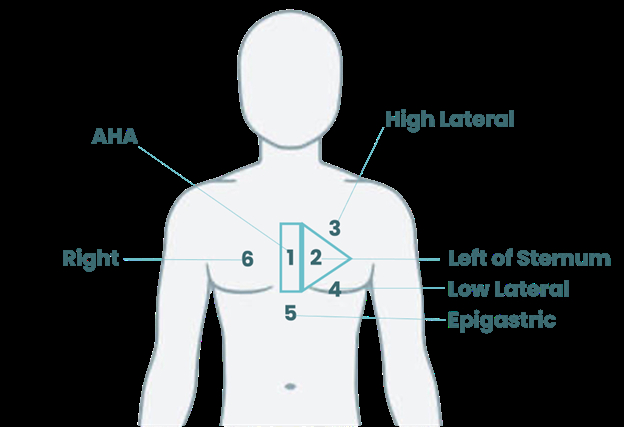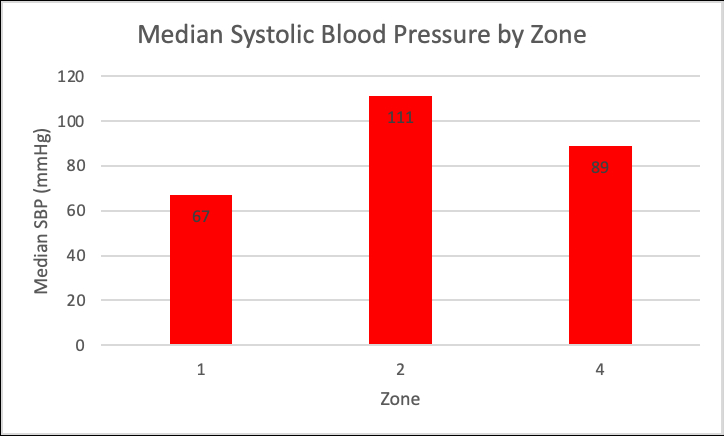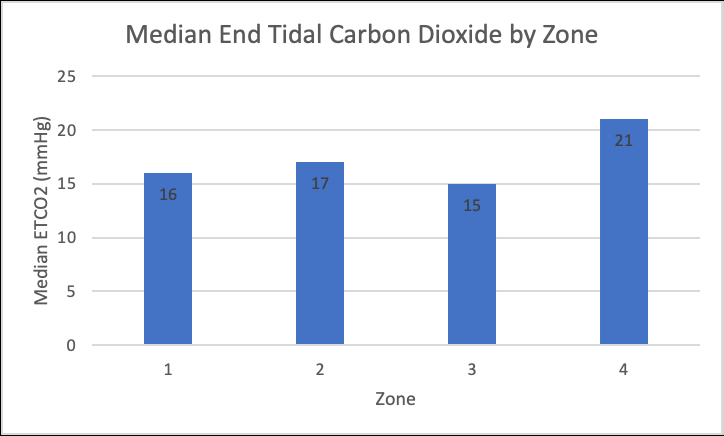Final ID: Sa1007
Chest Compressions to the Left of the Sternum are Associated with Higher Systolic Blood Pressure than to the Lower Sternum
Abstract Body: Introduction/Background
Despite over 60 years of cardiopulmonary resuscitation (CPR), there is a paucity of evidence assessing the optimal location to perform chest compressions during cardiac arrest. Some recent imaging studies with transesophageal echocardiography (TEE) and computed tomography (CT) show that the left ventricular outflow tract (LVOT) is often the site of maximum compression with CPR, if using the AHA recommended site of the lower half of the sternum.
Research Questions/Hypothesis
We hypothesize that chest compressions performed to the left of the sternum, where the left ventricle is more likely to be located, will be associated with higher systolic blood pressure (SBP) than those performed at the AHA-recommended lower half of the sternum.
Goals/Aims
Our primary aim was to compare the highest SBP, measured on a femoral arterial line, during a chest compression (CC) interval at the AHA recommended location (Zone 1, Figure) versus those performed to the left of the sternum (Zone 2, 3, or 4, Figure). Secondarily, we compared the highest end-tidal CO2 (ETCO2) for chest compression intervals performed at Zone 1 vs. Zone 2, 3, or 4.
Methods/Approach
We conducted a retrospective cohort study of video-recorded, adult, cardiac arrest resuscitations with changes in chest compression location in a quaternary care Emergency Department (ED) from 3/9/2021 to 2/20/2024. We excluded chest compressions at Zone 5 or 6. Wilcoxon rank sum tests were used to assess differences in SBP and ETCO2 among chest compressions performed at Zone 1 vs. Zones 2, 3, or 4.
Results/Data
24 patients had SBP or ETCO2 recordings, 11 patients with SBP recordings, 18 patients with ETCO2 recordings, and 5 patients with both. For SBP, there were 28 CC intervals in Zone 1 and 32 CC intervals in Zone 2 or 4. The median SBP for Zone 1 was 67 mmHg (IQR 52.25-86.75 mmHg) vs. 103 mmHg (IQR 79-125 mmHg) for Zone 2 or 4 (p<0.001). For ETCO2, there were 44 CC intervals for Zone 1 and 32 for Zone 2, 3, or 4. The median ETCO2 in Zone 1 was 16 mmHg (IQR 12.75-23.75 mmHg) vs. 17.5 mmHg (IQR 13-31.25 mmHg) in Zone 2, 3, or 4 (p=0.517).
Conclusions
Chest compressions to the left of the sternum are associated with higher SBP than compressions at the AHA recommended lower half of the sternum. ETCO2 was similar regardless of chest compression location.
Despite over 60 years of cardiopulmonary resuscitation (CPR), there is a paucity of evidence assessing the optimal location to perform chest compressions during cardiac arrest. Some recent imaging studies with transesophageal echocardiography (TEE) and computed tomography (CT) show that the left ventricular outflow tract (LVOT) is often the site of maximum compression with CPR, if using the AHA recommended site of the lower half of the sternum.
Research Questions/Hypothesis
We hypothesize that chest compressions performed to the left of the sternum, where the left ventricle is more likely to be located, will be associated with higher systolic blood pressure (SBP) than those performed at the AHA-recommended lower half of the sternum.
Goals/Aims
Our primary aim was to compare the highest SBP, measured on a femoral arterial line, during a chest compression (CC) interval at the AHA recommended location (Zone 1, Figure) versus those performed to the left of the sternum (Zone 2, 3, or 4, Figure). Secondarily, we compared the highest end-tidal CO2 (ETCO2) for chest compression intervals performed at Zone 1 vs. Zone 2, 3, or 4.
Methods/Approach
We conducted a retrospective cohort study of video-recorded, adult, cardiac arrest resuscitations with changes in chest compression location in a quaternary care Emergency Department (ED) from 3/9/2021 to 2/20/2024. We excluded chest compressions at Zone 5 or 6. Wilcoxon rank sum tests were used to assess differences in SBP and ETCO2 among chest compressions performed at Zone 1 vs. Zones 2, 3, or 4.
Results/Data
24 patients had SBP or ETCO2 recordings, 11 patients with SBP recordings, 18 patients with ETCO2 recordings, and 5 patients with both. For SBP, there were 28 CC intervals in Zone 1 and 32 CC intervals in Zone 2 or 4. The median SBP for Zone 1 was 67 mmHg (IQR 52.25-86.75 mmHg) vs. 103 mmHg (IQR 79-125 mmHg) for Zone 2 or 4 (p<0.001). For ETCO2, there were 44 CC intervals for Zone 1 and 32 for Zone 2, 3, or 4. The median ETCO2 in Zone 1 was 16 mmHg (IQR 12.75-23.75 mmHg) vs. 17.5 mmHg (IQR 13-31.25 mmHg) in Zone 2, 3, or 4 (p=0.517).
Conclusions
Chest compressions to the left of the sternum are associated with higher SBP than compressions at the AHA recommended lower half of the sternum. ETCO2 was similar regardless of chest compression location.
More abstracts on this topic:
Chest Compression Quality Phenotypes and ROSC in Out-of-Hospital Cardiac Arrest
Raya Krishnamoorthy Banu Priya, Daya Mohamud, Nichol Graham, Stephens Shannon, Carlson Jestin, Panchal Ashish, Wang Henry, Nassal Michelle, Gage Christopher, Kamholz Jacob, Elola Andoni, Aramendi Elisabete, Jaureguibeitia Xabier, Idris Ahamed, Aufderheide Tom
A Novel Method to Assess the Brain Functional Condition through Visualization of its Emitted Infrared Waves.Ghevondyan Tigran



